With the addition of Vatican Reg.lat.165, we have verified that 4 saints in a single date now loads and processes correctly. Taking a step backwards, this is a Use of Rome hours with a Calendar from Aquilla (probably) that may have been owned by Queen Christina of Sweden. The calendar is either unfinished or the scribe was confused, each entry is missing the initial letter, eg. "pyphania do" for Jan-6, missing the initial "E". For testing, though, August 22 (see f.6v below) is the critical date, having entries for Sts. Hyppolitus (471), Timothy (478) and Symphorian (477), and the Octave of the Assumption (469). This was entered into the new 4-saint Excel template and it loaded and displayed cleanly!
(DB Id: 149)
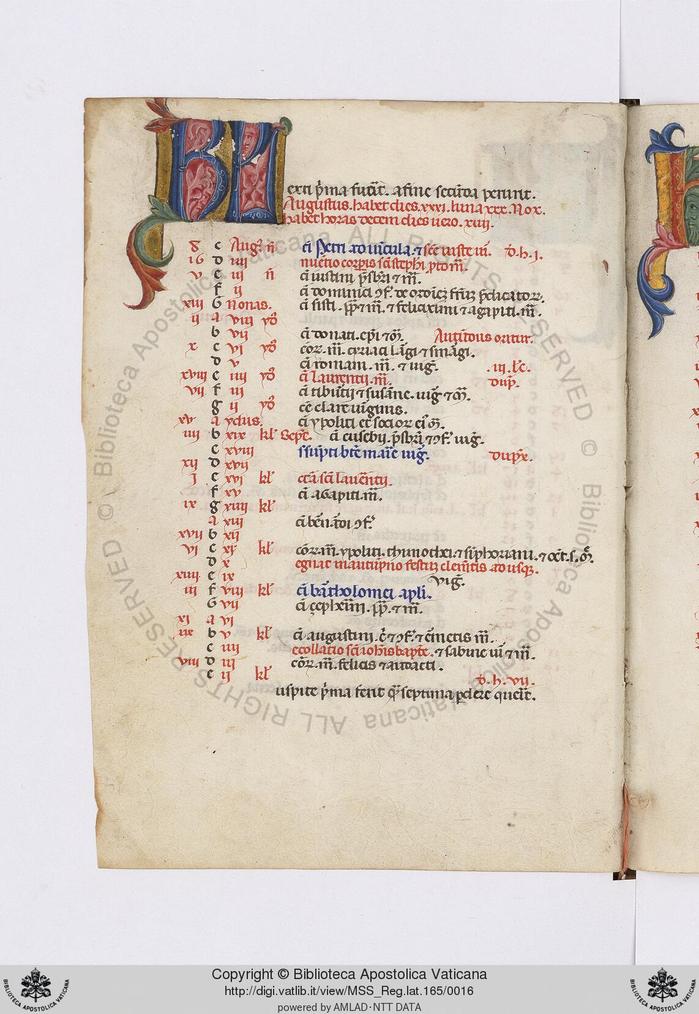
A bunch of changes have been underway in the background. First a big procedural one - I'm going to be trying to post shorter pieces about newly added MS to twitter: @cokldb. I've added about 10 MS recently, and many of those are mentioned there. When I have a longer discussion, I may still post here.
In the backend, we now support up to 4 different saints per date! This required changes in a bunch of places, and may not be perfect, but seems to work. There are not many books in the DB with more than 2 per date, about 30 entries have 3 saints and 3 have 4. This is one of the places that need work, I scanned the existing entries for ones marked as "three saints" or "four saints" but if I was inconsistant, I may not have found all of them. The loader/excel template was also updated to handle 4 entries and 4 colors.
The current work, yet undeployed, is to get some statistical graphs into the date detail pages. Ideally a pie chart of "blank vs populated" and then a breakdown of saints in the populated ones. The data is in place, what is taking work is a good display
Two more from the Biblioteca Nacional de Espana.
Res/149, the Hours of Guillaume Rollin, was made in Valenciennes around 1460-70. The calendar is rather plain, with nothing but some penwork around the KL for decoration. It is, however, very accurate. Of 185 entries, only three are on the wrong date. Of the entries, there are no unique ones, but having Cornelius and Cyprianus (3696) on September 14th, in addition to the Exaltation of the Cross (3693), is an less common pairing.
(DB Id: 291)
Vitr/25/5, the Book of Hours Voustre Demeure, was made in Ghent circa 1472. As opposed to Res/149, above, the calendar here is nearly complete and heavily decorated. Each of the pages has illusionistic borders populated with insect, plants, and bugs. At the bottom of the versos, where the months start, there is a vignette of the labor of the month. On the rectos there is a scene with the zodiac in the sky over a seasonal landscape.
The entries in the calendar are less careful. It seems that the intent was to have a complete calendar, but in many months the insertion of the word “Nonas” (Mar., Apr., July, Oct., Nov., or Dec.) or “Idus” (Aug.) has filled the line and no saint exists for that day. There are only two actually empty dates, Oct. 26 and Dec. 14. As is common in complete calendars there are a fair number of unidentified saints and 30 on incorrect dates. One of the errors is St. Columba (4146), listed on Dec. 19. Though her feast should be on the 17th, there is one other manuscript in the DB, Walters W.195, with the same shifted saint. These are both Flemish MS from the late 15th century, and though there is no other known connection, this may indicate one.
(DB Id: 292)
From the Bibliothèque nationale de France comes Latin 1173, the Hours of Charles d’Angoulême, made in France in the Late 15th C. Charles was the father of King François I(r. 1515-1547), and is identified by his arms on f.53r. The Hours are Use of Paris, but the calendar has not been localized.
Most of the literature on this MS is not focused on the text at all, but either the miniatures. Many of these are originals by Robinet Testard, but several are actually prints by Israel van Meckenem (signed IM), which have been colored and embellished by Testard. The calendar is populated with quite distinct illustrations. The labors of the month are unusual and 9 of the KL initials are formed by humans, often in brown/blue clothing, contorted and posing with strange beasts. May (f.3r below) is a representative example, with the woman seemingly unconcerned by the dragon attacking her to form the arms of the “K”. What seems to be the labor is, in fact, two “wild men” jousting
In the content of the calendar there are both some unusual saints listed as well as an interesting bit of scribal error. The calendar starts out mostly full, 27 in Jan, but immediately starts to open up, with only 12 in February. In January some of the entries are quite rare, eg. the heretofore unique 40 Martyrs (4294) on Jan 9.
The calendar starts out triple-graded, blue/red/black, and is carefully graded, several multiple-saint entries are graded distinctly for each saint. In November, however, the scribe seems to forget that he’s triple-grading, and starts to use red and blue in simple alternation when there are high-ranks. This was less definitive in early November, All Saints (2850) in blue vs. All Souls (2993) in red, but becomes more evident as the month proceeds. In December it is unavoidable with strict alternation of red/blue in the Christmas (814) through Holy Innocents (823) block. Were this still triple graded, Christmas, in red, would be outranked by the Holy Innocents and even St. Barbara (853), both in blue.
(DB Id: 278)
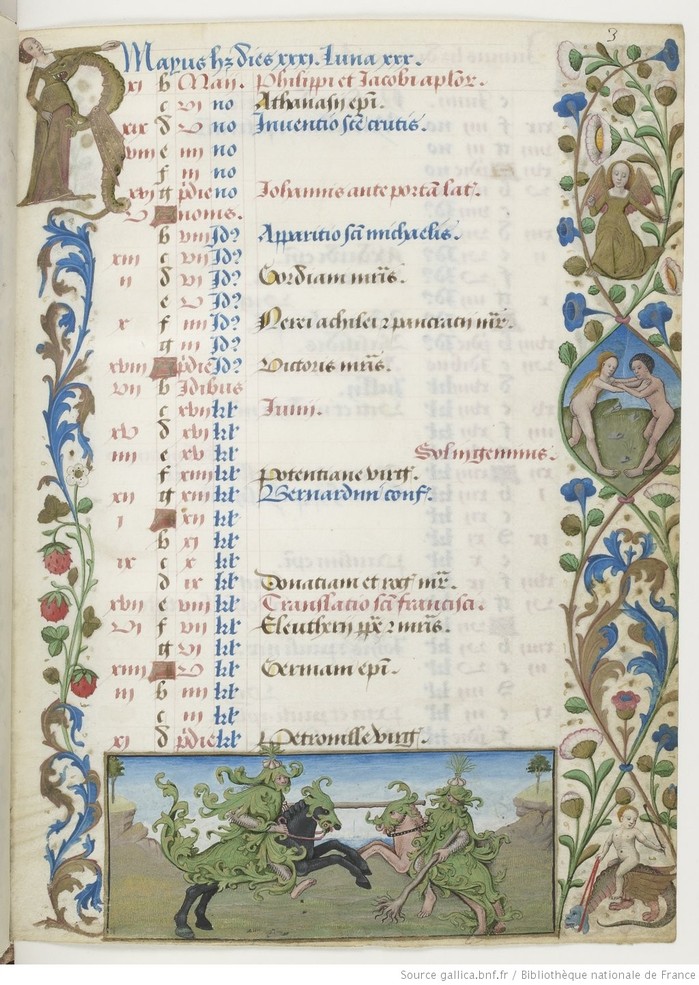
It’s not linked into all the proper places, but the initial “date detail” function is finally implemented. In the same basic mode of operation as “saint detail”, this returns a page with all the entries known for a particular date, as well as information about that date (currently Dominical Letter, Golden Number, and Roman Date). Future work will include some distribution graphs and a “Notes” field for the date, but at least there is a minimal function out there. Currently it is only linked from the date number in the “Saints by date” page, but that may increase.
There are a pair of permanent links, one as date id: http://cokl.wiglaf.org/p/v100/dateid/210
and another as the month/day: http://cokl.wiglaf.org/p/v100/date/7/29
We know more about the location of manuscript MS Lat 34 from the Bibliothèque de Genève, hosted by the excellent e-Codices, than we usually do. This was made for use in the Abbey of St. Martin, in Tours, France. Sadly the monastery was destroyed during the revolution due to St. Martin’s connection to the royal family, dating back to Clovis. The modern Basilica of St. Martin was built on the same site in the late 19th century.
The calendar is unusual in containing a large amount of non-festal dating. All of the Egyptian days are marked in full and there are the “keys” to both Rogation and Pentecost, though not for Easter, which is the most common. For Easter, there is a little poem on the outer margin of the first part of January (see f.3r below) that gives a simplified way of predicting the date. There’s also an entry for the day of Creation, according to Bede and the yet-unexplained “Septim[us] embolism[us]”. The saints are as expected. There are several feasts for St Martin, including the common, Translation on July 4 1854, and the uncommon, Subvention on May 12 2543, Octave of Translation on July 11 4220
(DB Id: 246
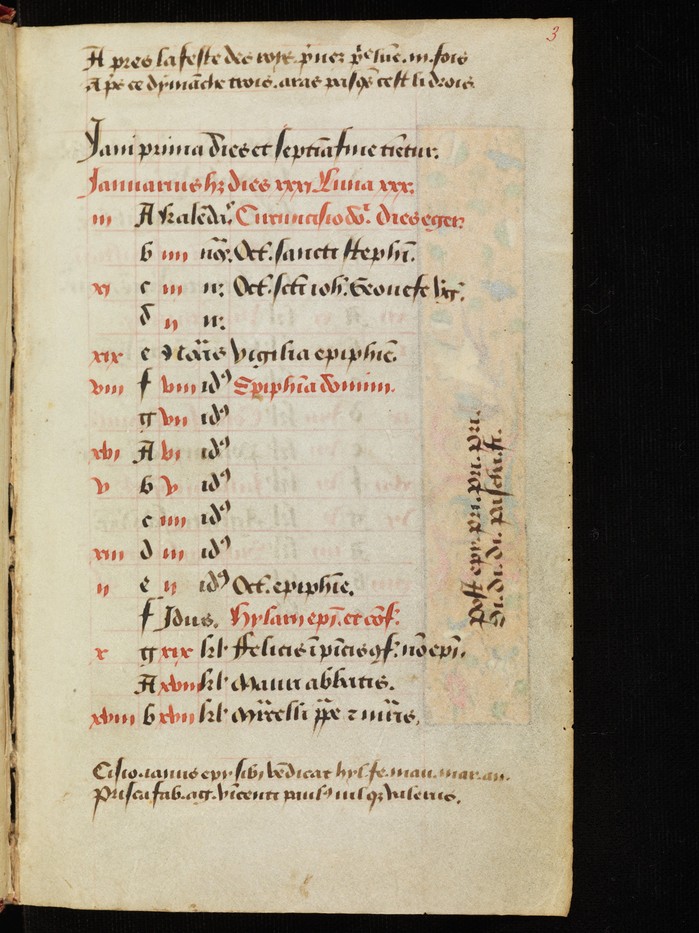
Shifted fully to the Master of the Black Prayerbook, or a follower, gives us Walters Art Museum W.190. It’s another late 15th C Flemish Book of Hours, this one somewhat difficult to localize between Bruges and Liege. It’s been rebound out of order at some point in its life, but having the digitized copy allows us to return it to a more sensible, if not demonstrably original, order.
The calendar is complete “in intent if not in execution”. A scribal error caused April to only have 29 entries, and it appears the feast for April 19 has been omitted. The saints have a very strong Bruges character, often following the unusual saints of that city. There are a few on the wrong dates, and a pair of strange errors. May 23 has “Transfigura[o] d[omi]ni”, where that day is actually the feast of the Translation, which is an unusual feast peculier to Bruges. A stranger error is September 13(see f.9r below), usually the feast of St. Philip, is here listed as “Philippi & Jacobi”. That feast is May 1, and so points to a scribal error rather than a copying error.
(DB Id: 211)
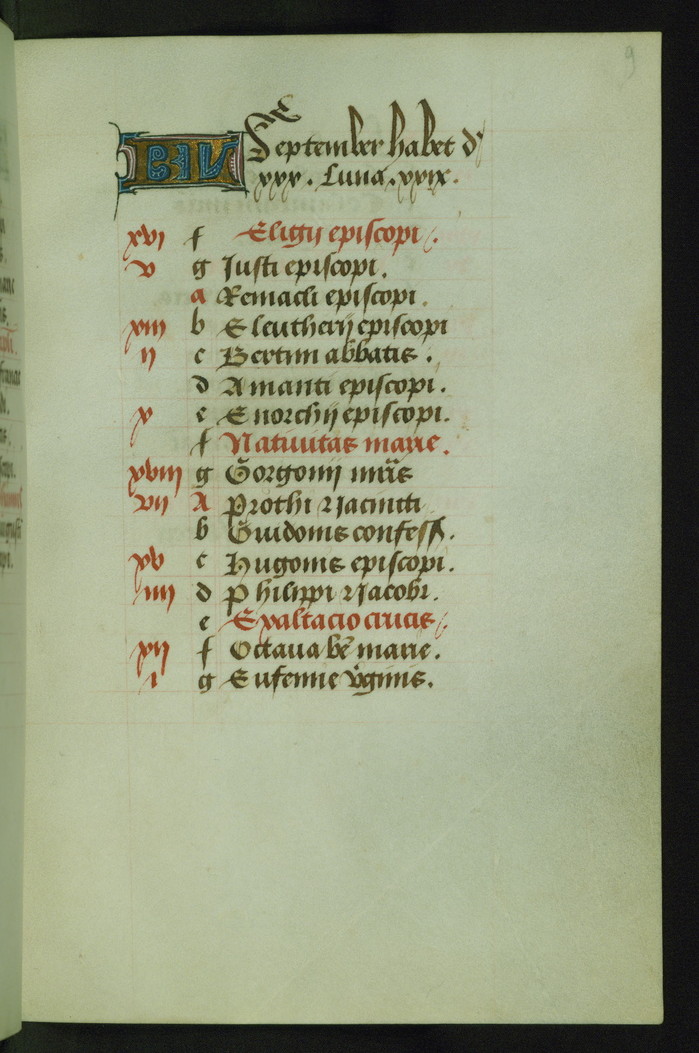
In Walters Art Museum W.189 Willem Vrelant worked with the Master of the Black Prayerbook to create the elaborate color-block foliate borders and full-page grisaille miniatures that fill the book. Even the KL at the top of each month of the calendar are carefully done in grisaille, backgrounded with brown that was hightened with a spray of gold spots.
The calendar entries are in Dutch, though the rest of the book is in Latin. There are only 124 saints in the calendar, mostly the usual ones. There are a few unusual saints, one is St. Brendan, written as “brandaris”, on May 16(see f.5v below). There are actually two Sts. Brendan on that day, and it’s unclear which is meant. Later in that month, May 22, is an unidentified St. Anthonis.
(DB Id: 210) 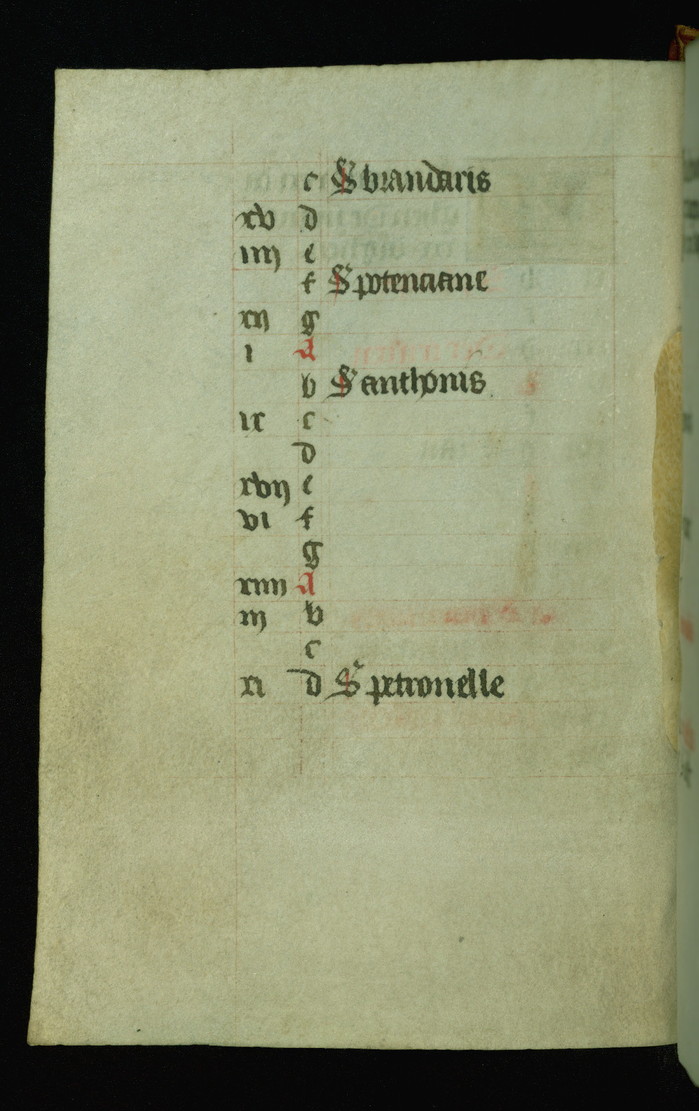
The Spinola Hours (Ludwig IX 18), owned by the Getty in Los Angeles since 1983, is mostly known for it spectacular illumination program, directed by the Master of the James IV of Scotland with contributions by the Master of the Dresden Prayer Book, the Master of the Lübeck Bible, the Master of the Prayer Books of around 1500, and the Workshop of Master of the First Prayer Book of Maximilian. The calendar has architectural borders, with various saints depicted(Philip and James, and the Invention of the Cross in f.3v below) in roundels and little pseudo-friezes with people playing games.
The entries of the calendar are less spectacular. It's a complete calendar, the only day without a saint (May 5, see f.3v below) is filled with the end of the following day's saint (Latina[m] from the end of John at the Porta Latina). Many of the names are very abbreviated, specifically the jobs, probaly due to the space constraints of the double column layout. The saints are a wide selection, with no obvious pattern, but they seem to align with the Flanders origin of the MS.
(DB Id: 202)
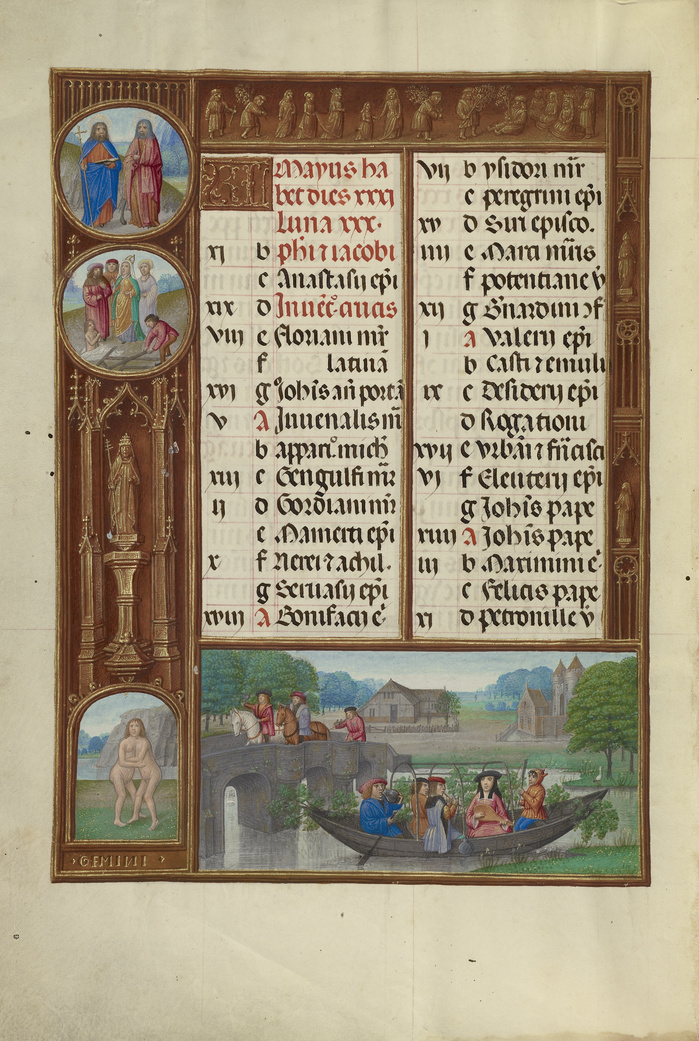
The Walters Art Museum has revamped their website, which makes finding their digitized assets easier. From the new website comes W.90, an early 14th Century Book from the area of St. Omer, France. The most interesting part of the manuscript, for most people, comes after the calendar. There are 7 full-page miniatures, depicting the beginning of Genisis, from Creation through the expulsion, contained within highly-detailed architectural frames.
The calendar itself is not uninteresting, though. It is an early example of a nearly complete calendar, 359 of the entries are populated. There are very few in red, not even all of the Apostles get ranked, and many of the major feasts lack Vigils. Both of these are more obvious at the beginning of the MS, the first vigil is June 23, Vigil for St. John, and there are only 10 red days through the end of May, but a total of 49.
The feasts named are a grab bag, some are common, some are specific to St. Omer (Translation of St. Audomer in June 6, Octave of St. Audomar on Sept 16 and Dedication of the Cathedral of St. Audomer on October 17), and some seem to be scribal errors. In this last category are some unusual errors, Mary of Egypt appears on August 4, where perhaps Mary ad Nives, usually Aug 5, was meant.
(DB Id: 198)





